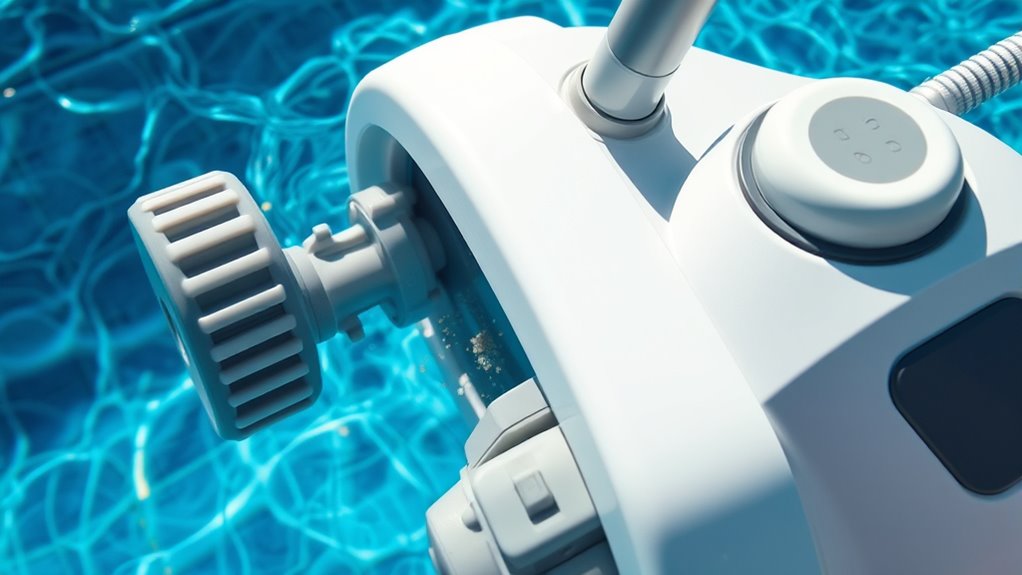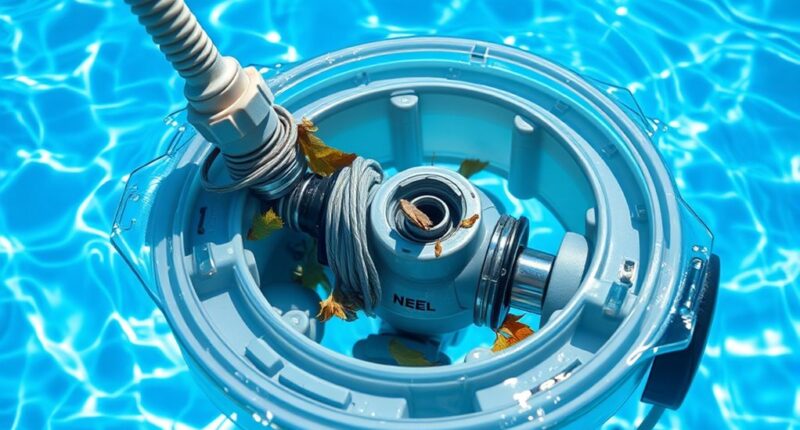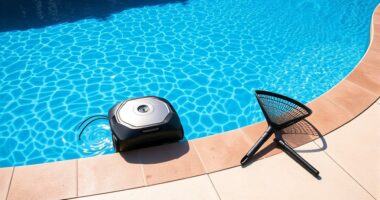If your automatic pool cleaner isn’t working well, start by checking and cleaning the filter to guarantee water flows freely. Inspect hoses for kinks or clogs and clear any debris from brushes or intake ports. Make sure all connections are secure and hoses aren’t tangled. Verify the pump and skimmer are functioning properly, and replace worn brushes or internal parts if needed. Proper maintenance now can resolve many issues—keep going to learn more tips to keep your cleaner running smoothly.
Key Takeaways
- Regularly inspect and clean filters to maintain water flow and debris pickup efficiency.
- Check brushes and intake ports for tangled debris or obstructions, replacing worn parts as needed.
- Ensure hoses are free of kinks and securely connected to allow proper movement and suction.
- Verify pump pressure and clean skimmer baskets to optimize internal component performance.
- Perform routine maintenance and consult professionals for worn or malfunctioning parts to prevent issues.

Automatic pool cleaners can make maintaining your pool much easier, but when they stop working properly, it can be frustrating. One common issue is that the cleaner isn’t effectively removing debris or circulating water as it should. To troubleshoot these problems, start by checking the filter. Regular filter maintenance is essential for peak performance. If the filter is clogged or dirty, the cleaner won’t be able to pick up debris efficiently. Remove the filter cartridge or basket, rinse it thoroughly with a hose, and replace it if it’s damaged or excessively worn. Making sure the filter is clean allows water to flow freely, which helps the cleaner perform its debris removal duties properly.
Regularly clean the filter to ensure your pool cleaner works efficiently.
Next, examine the cleaner’s debris removal capabilities. If it’s not picking up debris, it could be because the brushes or wheels are clogged or worn out. Carefully inspect the brushes for any tangled hair, leaves, or debris, and clear them out. Worn brushes may need replacing to restore cleaning power. Also, check the cleaner’s intake ports and jets for obstructions. Debris can block these openings, reducing suction and movement. Clearing any blockages restores proper water flow, allowing the cleaner to pick up debris more effectively.
Another common issue involves the cleaner’s movement in the pool. If it’s not moving around as it should, check the hoses and connections. Ensure the hose is not kinked or tangled, as this can restrict movement. Properly connect the hose to both the cleaner and the skimmer or dedicated suction line, making sure all fittings are secure. Sometimes, a simple hose adjustment can fix movement issues and improve debris removal. Additionally, understanding the importance of regular maintenance can help prevent many of these issues from occurring in the first place. Regularly inspecting and maintaining your pool equipment, including the filter, helps ensure optimal operation and longevity of your automatic cleaner.
Furthermore, consider checking the automatic cleaner’s internal components for signs of wear or damage, as these can directly affect performance. If your automatic cleaner still isn’t performing well, verify the pump and skimmer basket. A weak pump or a full skimmer basket can reduce suction power, impacting the cleaner’s efficiency. Clean out the skimmer basket and make sure the pool pump is operating at the correct pressure. Increasing pump speed temporarily might boost debris removal, but avoid overworking your system.
Finally, if you’ve gone through all these steps and the cleaner still isn’t functioning properly, consider inspecting the drive motor or internal components. Worn or malfunctioning parts can cause it to stop moving or cleaning adequately. Replacing faulty parts or consulting a professional can often resolve these issues quickly. Regular maintenance, including filter cleaning and debris removal, keeps your automatic pool cleaner working smoothly, making pool upkeep less of a chore and more of a hassle-free experience.
Frequently Asked Questions
How Often Should I Replace My Pool Cleaner’S Brushes?
You should replace your pool cleaner’s brushes based on your maintenance schedule or if they show signs of wear. Typically, it’s a good idea to check them every few months and replace when they become frayed, cracked, or worn down. Regular brush replacement guarantees peak cleaning performance. Keep an eye on their condition, and don’t wait too long—prompt maintenance keeps your pool cleaner running smoothly and extends its lifespan.
Can I Use My Automatic Pool Cleaner in Saltwater Pools?
Think of your pool cleaner as a sailor steering through different waters. You wonder if it can handle the saltwater, and the answer is yes—most are saltwater compatible. However, to guarantee smooth sailing, you must perform regular cleaner maintenance, checking for corrosion and wear. Always verify your model’s saltwater compatibility, and maintain it properly, so your cleaner continues to work efficiently without damage from the salty seas.
What’S the Best Way to Store My Pool Cleaner During Winter?
For winter storage, you should thoroughly clean your pool cleaner, removing any debris and rinsing it with fresh water to prevent corrosion. Store the equipment in a cool, dry place, ideally indoors, to guard it from freezing temperatures. During winter storage, perform regular equipment maintenance, checking for wear or damage. This ensures your automatic pool cleaner stays in good condition, ready to operate efficiently when swimming season returns.
How Do I Reset My Pool Cleaner’S Motor?
Think of your pool cleaner’s motor reset as hitting a refresh button for smooth sailing. To reset the motor, first turn off the power and unplug it. Wait a few minutes, then press and hold the reset button, if available. Follow troubleshooting steps like checking for blockages or debris. Once done, restore power, and your cleaner should be back in action, ready to keep your pool gleaming.
Are There Eco-Friendly Options for Automatic Pool Cleaners?
You wonder if there are eco-friendly options for automatic pool cleaners. You’ll find solar-powered options that harness sunlight, reducing energy consumption and lowering your carbon footprint. Additionally, some models use biodegradable materials, making them safer for the environment and easier to recycle. These choices help you clean your pool effectively while staying eco-conscious. Switching to such options supports sustainability and minimizes your impact on the planet.
Conclusion
Think of your pool cleaner like a trusted friend who keeps your oasis sparkling. When it hiccups, don’t panic—troubleshooting is your way of tuning up that friendship. I once watched a cleaner restart after a quick coil adjustment, and it glided smoothly again, like a boat catching the wind. With a little patience, you’ll have your pool looking pristine, turning a frustrating moment into a simple fix—because every problem has a smooth sailing solution.









